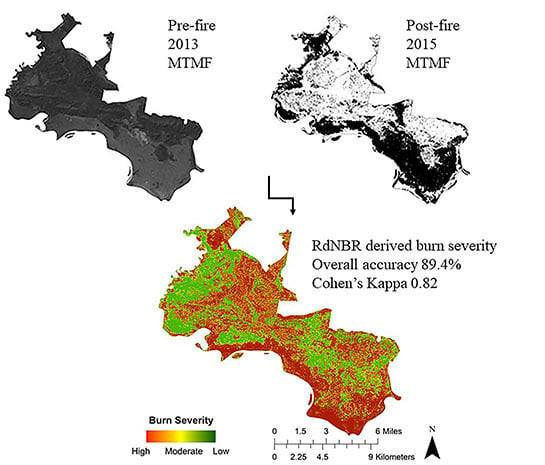Remote Sensing Approach to Detect Burn Severity Risk Zones in Palo Verde National Park, Costa Rica
Abstract
:1. Introduction
Study Site
2. Materials and Methods
2.1. Data Acquisition and Preprocessing
- ρλ’ = ToA planetary reflectance, without correction for solar angle. Note that ρλ’ does not contain a correction for the sun angle
- Mρ = Band-specific multiplicative rescaling factor from the metadata
- (REFLECTANCE_MULTI_BAND_x, where x is the band number)
- Aρ = Band-specific additive rescaling factor from the metadata
- (REFLECTANCE_ADD_BAND_x, where x is the band number)
- Qcal = Quantized and calibrated standard product pixel values (DN)
- ρλ = ToA planetary reflectance
- θSE = Local sun elevation angle as SUN_ELEVATION
- θSZ = Local solar zenith angle; θSZ = 90° − θSE
2.2. Slope Analysis
2.3. Image Analysis
2.4. Statistical Analysis
2.4.1. Comparison of Ground Data with Image Pixels
2.4.2. Accuracy Assessment
3. Results
3.1. Data Acquisition and Preprocessing
3.2. Slope Analysis
3.3. Image Analysis
3.4. Statistical Analysis
3.4.1. Comparison of Ground Data with Image Pixels
3.4.2. Accuracy Assessment
4. Discussion
4.1. Data Acquisition and Preprocessing
4.2. Slope Analysis
4.3. Image Analysis
4.4. Accuracy Assessment
4.5. Application and Implications
5. Conclusions
Author Contributions
Funding
Conflicts of Interest
References
- AL-Dhief, F.T.; Sabri, N.; Fouad, S.; Latiff, N.A.; Albader, M.A.A. A review of forest fire surveillance technologies: Mobile ad-hoc network routing protocols perspective. J. King Saud Univ.-Comput. Inf. Sci. 2017. [Google Scholar] [CrossRef]
- Goldammer, J.G. Forest on Fire. Science 1999, 284, 1782–1783. [Google Scholar] [CrossRef]
- Goldammer, J.G.; Jenkins, M.J. Fire in Ecosystem Dynamics, Mediterranean and Northern Perspectives; SPB Academic Publishing: The Hague, The Netherlands, 1990. [Google Scholar]
- Nepstad, D.C.; Verssimo, A.; Alencar, A.; Nobre, C.; Lima, E.; Lefebvre, P.; Schlesinger, P.; Potter, C.; Moutinho, P.; Mendoza, E.; et al. Large-scale impoverishment of Amazonian forests by logging and fire. Nature 1999, 398, 505. [Google Scholar] [CrossRef]
- Madurapperuma, B.D.; Kuruppuarachchi, K.A.J.M. Detecting land-cover change using mappable vegetation related indices: A case study from Sinharaja Man and the Biosphere Reserve. J. Trop. For. Environ. 2014, 4, 50–58. [Google Scholar] [CrossRef]
- Agee, J.K. Fire Ecology of Pacific Northwest Forests; Island Press: Washington, DC, USA, 1993. [Google Scholar]
- Daniels, A.E.; Cumming, G.S. Conversion or conservation? Understanding wetland change in Northwest Costa Rica. Ecol. Appl. 2008, 18, 49–63. [Google Scholar] [CrossRef] [PubMed]
- Millennium Ecosystem Assessment. Ecosystems and Human Well-Being: Wetlands and Water Synthesis; World Resources Institute: Washington, DC, USA, 2005. [Google Scholar]
- Leblon, B.; Bourgeau-Chavez, L.; San-Miguel-Ayanz, J. Use of remote sensing in wildfire management. In Sustainable Development-Authoritative and Leading Edge Content for Environmental Management; IntechOpen: London, UK, 2012. [Google Scholar] [CrossRef]
- Chuvieco, E.; Kasischke, E.S. Remote sensing information for fire management and fire effects assessment. J. Geophys. Res. 2007, 112. [Google Scholar] [CrossRef] [Green Version]
- Lanorte, A.; Danese, M.; Lasaponara, R.; Murgante, B. Multiscale mapping of burn area and severity using multisensor satellite data and spatial autocorrelation analysis. Int. J Appl. Earth Obs. 2013, 20, 42–51. [Google Scholar] [CrossRef]
- Meng, R.; Wu, J.; Schwager, K.L.; Zhao, F.; Dennison, P.E.; Cook, B.D.; Brewster, K.; Green, T.M.; Serbin, S.P. Using high spatial resolution satellite imagery to map forest burn severity across spatial scales in a Pine Barrens ecosystem. Remote Sens. Environ. 2017, 191, 95–109. [Google Scholar] [CrossRef]
- Epting, I.; Verbyla, D.; Sorbel, B. Evaluation of remotely sensed indices for assessing burn severity in interior Alaska using Landsat TM and ETM+. Remote Sens. Environ. 2005, 96, 328–339. [Google Scholar] [CrossRef]
- Fernández-García, V.; Quintano, C.; Taboada, A.; Marcos, E.; Calvo, L.; Fernández-Manso, A. Remote sensing applied to the study of fire regime attributes and their influence on post-fire greenness recovery in Pine ecosystems. Remote Sens. 2018, 10, 733. [Google Scholar] [CrossRef]
- Van Wagtendonk, J.W.; Root, R.R.; Key, C.C. Comparison of AVIRIS and Landsat ETM+ detection capabilities for burn severity. Remote Sens. Environ. 2004, 92, 397–408. [Google Scholar] [CrossRef]
- White, J.D.; Ryan, K.C.; Key, C.C.; Running, S.W. Remote sensing of forest fire severity and vegetation recovery. Int. J. Wildland Fire 1996, 6, 125–136. [Google Scholar] [CrossRef]
- Lutes, D.C.; Keane, R.E.; Caratti, J.F.; Key, C.H.; Benson, N.C.; Sutherland, S.; Gangi, L.J. FIREMON: Fire Effects Monitoring and Inventory System; Tech. Rep. RMRS-GTR-164-CD; US Department of Agriculture Forest Service, Rocky Mountain Research Station: Fort Collins, CO, USA, 2006. [Google Scholar]
- Miller, J.D.; Thode, A.E. Quantifying burn severity in a heterogeneous landscape with a relative version of the delta Normalized Burn Ratio (dNBR). Remote Sens. Environ. 2007, 109, 66–80. [Google Scholar] [CrossRef]
- Parks, S.A.; Dillon, G.K.; Miller, C. A new metric for quantifying burn severity: The relativized burn ratio. Remote Sens. 2014, 6, 1827–1844. [Google Scholar] [CrossRef]
- Miller, J.D.; Knapp, E.E.; Key, C.H.; Skinner, C.N.; Isbell, C.J.; Creasy, R.M.; Sherlock, J.W. Calibration and validation of the relative differenced Normalized Burn Ratio (RdNBR) to three measures of fire severity in the Sierra Nevada and Klamath Mountains, California, USA. Remote Sens. Environ. 2009, 113, 645–656. [Google Scholar] [CrossRef]
- Zhu, Z.; Key, C.; Ohlen, D.; Benson, N. Evaluate Sensitivities of Burn-Severity Mapping Algorithms for Different Ecosystems and Fire Histories in the United States; Final Report to the Joint Fire Science Program; Project: JFSP 01-1-4-12; USGS EROS: Sioux Falls, SD, USA, 2006.
- Cansler, C.A.; McKenzie, D. How robust are burn severity indices when applied in a new region? Evaluation of alternate field-based and remote-sensing methods. Remote Sens. 2012, 4, 456–483. [Google Scholar] [CrossRef]
- Landmann, T. Characterizing sub-pixel Landsat ETM+ fire severity on experimental fires in the Kruger National Park, South Africa. S. Afr. J. Sci. 2003, 99, 357–360. [Google Scholar]
- Smith, A.M.S.; Wooster, M.J.; Drake, N.A.; Dipotso, F.M.; Falkowski, M.J.; Hudak, A.T. Testing the potential of multi-spectral remote sensing for retrospectively estimating fire severity in African Savannahs. Remote Sens. Environ. 2005, 97, 92–115. [Google Scholar] [CrossRef]
- Boardman, J.W. Leveraging the high dimensionality of AVIRIS data for improved subpixel target unmixing and rejection of false positives: Mixture tuned matched filtering. In Proceedings of the Summaries of the Seventh Annual JPL Airborne Earth Science Workshop, Pasadena, CA, USA, 12–16 January 1998. [Google Scholar]
- Harsanyi, J.C.; Chang, C.I. Hyperspectral image classification and dimensionality reduction: An orthogonal subspace projection approach. IEEE Trans. Geosci. Remote Sens. 1994, 32, 779–785. [Google Scholar] [CrossRef]
- Boardman, J.W.; Kruse, F.A.; Green, R.O. Mapping target signatures via partial unmixing of AVIRIS data. In Proceedings of the Summaries of the Fifth Annual JPL Airborne Earth Science Workshop, Pasadena, CA, USA, 23–26 January 1995; Green, R.O., Ed.; NASA JPL: Pasadena, CA, USA, 1995; pp. 23–26. [Google Scholar]
- Glenn, N.F.; Mundt, J.T.; Weber, K.T.; Prather, T.S.; Lass, L.W.; Pettingill, J. Hyperspectral data processing for repeat detection of small infestations of leafy spurge. Remote Sens. Environ. 2005, 95, 399–412. [Google Scholar] [CrossRef]
- Harris, A.; Bryant, R.G.; Baird, A.J. Mapping the effects of water stress on Sphagnum: Preliminary observations using airborne remote sensing. Remote Sens. Environ. 2006, 100, 363–378. [Google Scholar] [CrossRef]
- Mundt, J.T.; Glenn, N.F.; Weber, K.T.; Prather, T.S.; Lass, L.W.; Pettingill, J. Discrimination of hoary cress and determination of its detection limits via hyperspectral image processing and accuracy assessment techniques. Remote Sens. Environ. 2005, 96, 509–517. [Google Scholar] [CrossRef]
- Williams, A.P.; Hunt, E.R. Estimation of leafy spurge cover from hyperspectral imagery using mixture tuned matched filtering. Remote Sens. Environ. 2002, 82, 446–456. [Google Scholar] [CrossRef]
- Smith, M.O.; Ustin, S.L.; Adams, J.B.; Gillespie, A.R. Vegetation in deserts: I. A regional measure of abundance from multi-spectral images. Remote Sens. Environ. 1990, 31, 1–26. [Google Scholar] [CrossRef]
- Boardman, J.W.; Kruse, F.A. Automated spectral analysis: A geological example using AVIRIS data, North Grapevine Mountains, Nevada. In Proceedings of the Tenth Thematic Conference on Geological Remote Sensing, San Antonio, TX, USA, 9–12 May 1994; Environmental Research Institute of Michigan: San Antonio, TX, USA, 1994; pp. 407–418. [Google Scholar]
- Kirksey, E. Living with parasites in Palo Verde national park. Environ. Hum. 2012, 1, 23–55. [Google Scholar] [CrossRef]
- Lindner, M.; Garcia-Gonzalo, J.; Kolström, M.; Geen, T.; Reguera, R.; Maroschek, M.; Seidl, R.; Lexer, M.J.; Netherer, S.; Schopf, A.; et al. Impacts of Climate Change on European Forests and Options for Adaptation. Available online: https://ec.europa.eu/agriculture/external-studies/euro-forests_en (accessed on 6 September 2018).
- Pausas, J.G.; Llovet, J.; Rodrigo, A.; Vallejo, R. Are wildfires a disaster in the Mediterranean basin?—A review. Int. J. Wildland Fires 2008, 17, 713–723. [Google Scholar] [CrossRef]
- González-de-Vega, S.; De las Heras, J.; Moya, D. Resilience of Mediterranean Terrestrial ecosystems and fire severity in semiarid areas: Responses of Aleppo pine forests in the short, mid and long term. Sci. Total Environ. 2016, 573, 1171–1177. [Google Scholar] [CrossRef] [PubMed]
- Céspedes, B.; Luna, B.; Pérez, B.; Urbieta, I.R.; Moreno, J. Burning season effects on the short-term post-fire vegetation dynamics of a Mediterranean heathland. Appl. Veg. Sci. 2014, 17, 86–96. [Google Scholar] [CrossRef]
- Pausas, J.G.; Keeley, J.E. Evolutionary ecology of resprouting and seeding in fireprone ecosystems. New Phytol. 2014, 204, 55–65. [Google Scholar] [CrossRef] [PubMed]
- Varela, M.E.; Benito, E.; Keizer, J.J. Influence of wildfire severity on soil physical degradation in two pine forest stands of NW Spain. Catena 2015, 133, 342–348. [Google Scholar] [CrossRef]
- Alvarado Quesada, G.M. The importance of Costa Rica for resident and migratory waterbirds. In Waterbirds around the World; Boere, G.C., Galbraith, C.A., Stroud, D.A., Eds.; The Stationery Office: Edinburgh, UK, 2006; pp. 161–165. [Google Scholar]
- Mateo-Varga, J. Caracteristicasgenerales de la Cuenca del Rio Tempisque. In La Cuenca del Rio Tempisque, Perspectivas para un ManejoIntegrado; Jime´nez, J.A., Gonzalez, E., Eds.; Organizacio´n para EstudiosTropicales: San Jose, Costa Rica, 2001; pp. 32–72. Available online: http://www.wetlands.org/Reports/SiteReports/CostaRica/6CR001/6CR001_ManPlansp.pdf (accessed on 27 July 2017).
- Adair, C.; Mora, N.B.; Laing, J.; Rogers, Z. Restoration of the Wetlands in Palo Verde National Park: A Legal and Ecological Analysis; Final Report to Joint Program in Environmental Law; University of Florida and University of Costa Rica: San Jose, Costa Rica, 2012; Available online: https://www.law.ufl.edu/_pdf/academics/academic-programs/study-abroad/costa-rica/Ramsar-Report.pdf (accessed on 25 May 2018).
- Luger, P.; Guinn, J. Geospatial analysis of effects of human-induced wetland fire on semi-fossorial turtles in Palo Verde, Costa Rica. In Proceedings of the First Americans Land-Grant Consortium (Falcon), Poster Presentations, NIFA Waterfront Centre, Washington, DC, USA, 17–20 October 2009; Volume 4. [Google Scholar]
- Arias, L. Wildfire Destroys 5 Hectares of Costa Rica’s Palo Verde National Park. The Tico Times. 2015. Available online: http://www.ticotimes.net/2015/02/11/wildfire-destroys-5-hectares-of-costa-ricas-palo-verde-national-park (accessed on 20 April 2018).
- GLCF. Global Land Cover Facility. Available online: http://glcfapp.glcf.umd.edu:8080/esdi/index.jsp (accessed on 1 May 2018).
- Rozario, P.F.; Oduor, P.; Kotchman, L.; Kangas, M. Transition modeling of land-use dynamics in the Pipestem Creek, North Dakota, USA. J. Geosci. Environ. Prot. 2017, 5, 182–201. [Google Scholar] [CrossRef]
- Gomes, R.; Straub, J. Genetic algorithm for flood detection and evacuation route planning. In Proceedings of the Algorithms and Technologies for Multispectral, Hyperspectral, and Ultraspectral Imagery XXIII, Anaheim, CA, USA, 5 May 2017; Volume 10198, p. 1019816. [Google Scholar]
- Baloloy, A.B.; Blanco, A.C.; Gana, B.S.; Ana, R.C.; Olalia, L.C. LANDSAT-based detection and severity analysis of burned sugarcane plots in Tarlac, Philippines using differenced normalized burn ratio (dNBR). ISPRS Int. Arch. Photogramm. 2016, XLII-4/W1, 173–179. [Google Scholar] [CrossRef]
- Key, C.H.; Benson, N.C. Landscape assessment: Remote sensing of severity, the Normalized Burn Ratio; and ground measure of severity, the Composite Burn Index. In FIREMON: Fire Effects Monitoring and Inventory System, RMRS-GTR; USDA Forest Service, Rocky Mountain Research Station: Ogden, UT, USA, 2006. [Google Scholar]
- Howard, S.; Ohlen, D.; McKinley, R.; Zhu, Z.; Kitchen, J. Historical fire severity mapping from Landsat data. In Proceedings of the Pecora 15/Land Satellite Information IV/ISPRS Commission I/FIEOS Conference, Denver, CO, USA, 10–15 November 2002. [Google Scholar]
- Lopez Garcia, M.J.; Caselles, V. Mapping burns and natural reforestation using Thematic Mapper data. Geocarto Int. 1991, 1, 31–37. [Google Scholar] [CrossRef]
- McGrew, J.C., Jr.; Monroe, C.B. An Introduction to Statistical Problem Solving in Geography; Waveland Press: Long Grove, IL, USA, 2009. [Google Scholar]
- Zimmerman, P.L.; Housman, I.W.; Perry, C.H.; Chastain, R.A.; Webb, J.B.; Finco, M.V. An accuracy assessment of forest disturbance mapping in the western Great Lakes. Remote Sens. Environ. 2013, 128, 176–185. [Google Scholar] [CrossRef]
- Jensen, J.R. Remote Sensing of the Environment: An Earth Resource Perspective 2/e; Pearson Prentice Hall: Upper Saddle River, NJ, USA, 2007. [Google Scholar]
- Chang, C.W.; Laird, D.A.; Mausbach, M.J.; Hurburgh, C.R. Near-infrared reflectance spectroscopy–principal components regression analyses of soil properties. Soil Sci. Soc. Am. J. 2001, 65, 480–490. [Google Scholar] [CrossRef]
- Lewis, S.A.; Lentile, L.B.; Hudak, A.T.; Robichaud, P.R.; Morgan, P.; Bobbitt, M.J. Mapping ground cover using hyperspectral remote sensing after the 2003 Simi and Old wildfires in Southern California. Fire Ecol. 2007, 3, 109–128. [Google Scholar] [CrossRef]
- Amraoui, M.; DaCamara, C.C.; Pereira, J.M. Fire detection and monitoring over Africa. In Proceedings of the 2008 EUMETSAT Meteorological Satellite Conference, Darmstadt, Germany, 8–12 September 2008; p. 52. [Google Scholar]
- Santidrián-Tomillo, P.; Robinson, N.J.; Fonseca, L.G.; Quirós-Pereira, W.; Arauz, R.; Beange, M.; Piedra, R.; Vélez, E.; Paladino, F.V.; et al. Secondary nesting beaches for leatherback turtles on the Pacific coast of Costa Rica. Lat. Am. J. Aquat. Res. 2017, 45, 563–571. [Google Scholar] [CrossRef]
- Green, A.A.; Berman, M.; Switzer, P.; Craig, M.D. A transformation for ordering multispectral data in terms of image quality with implications for noise removal. IEEE Trans. Geosci. Remote Sens. 1988, 26, 65–74. [Google Scholar] [CrossRef] [Green Version]
- Fernández-García, V.; Santamarta, M.; Fernández-Manso, A.; Quintano, C.; Marcos, E.; Calvo, L. Burn severity metrics in fire-prone pine ecosystems along a climatic gradient using Landsat imagery. Remote Sens. Environ. 2018, 206, 205–217. [Google Scholar] [CrossRef]
- Chang, C.I.; Heinz, D.C. Constrained subpixel target detection for remotely sensed imagery. IEEE Trans. Geosci. Remote Sens. 2000, 38, 1144–1159. [Google Scholar] [CrossRef]
- Robichaud, P.R.; Lewis, S.A.; Laes, D.Y.; Hudak, A.T.; Kokaly, R.F.; Zamudio, J.A. Postfire soil burn severity mapping with hyperspectral image unmixing. Remote Sens. Environ. 2007, 108, 467–480. [Google Scholar] [CrossRef]
- Jia, G.J.; Burke, I.C.; Goetz, A.F.H.; Kaufmann, M.R.; Kindel, B.C. Assessing spatial patterns of forest fuel using AVIRIS data. Remote Sens. Environ. 2006, 102, 318–327. [Google Scholar] [CrossRef]
- Pontius, R.G., Jr.; Millones, M. Death to Kappa: Birth of quantity disagreement and allocation disagreement for accuracy assessment. Int. J. Remote Sens. 2011, 32, 4407–4429. [Google Scholar] [CrossRef]
- Stein, A.; Aryal, J.; Gort, G. Use of the Bradley-Terry model to quantify association in remotely sensed images. IEEE Trans. Geosci. Remote 2005, 43, 852–856. [Google Scholar] [CrossRef]
- Walz, Y.; Maier, S.W.; Dech, S.W.; Conrad, C.; Colditz, R.R. Classification of burn severity using Moderate Resolution Imaging Spectroradiometer (MODIS): A case study in the jarrah-marri forest of southwest Western Australia. J. Geophys. Res. Biogeosci. 2007, 112. [Google Scholar] [CrossRef] [Green Version]
- Ye, S.; Pontius, R.G.; Rakshit, R. A review of accuracy assessment for object-based image analysis: From per-pixel to per-polygon approaches. ISPRS J. Photogramm. 2018, 141, 137–147. [Google Scholar] [CrossRef]
- Jensen, J.R. Introductory Digital Image Processing: A Remote Sensing Perspective, 3rd ed.; Prentice-Hall, Inc.: Upper Saddle River, NJ, USA, 2005. [Google Scholar]
- Michalek, J.L.; French, N.H.F.; Kasischke, E.S.; Johnson, R.D.; Colwell, J.E. Using Landsat TM data to estimate carbon release from burned biomass in an Alaskan spruce forest complex. Int. J. Remote Sens. 2000, 21, 323–338. [Google Scholar] [CrossRef] [Green Version]
- Isaev, A.S.; Korovin, G.N.; Bartalev, S.A.; Ershov, D.V.; Janetos, A.; Kasischke, E.S.; Shugart, H.H.; French, N.H.F.; Orlick, B.E.; Murphy, T.L. Using remote sensing to assess Russian forest fire carbon emissions. Clim. Chang. 2002, 55, 235–249. [Google Scholar] [CrossRef]
- Díaz-Delgado, R.; Lloret, F.; Pons, X. Influence of fire severity on plant regeneration by means of remote sensing imagery. Int. J. Remote Sens. 2003, 24, 1751–1763. [Google Scholar] [CrossRef] [Green Version]
- Cocke, A.E.; Fulé, P.Z.; Crouse, J.E. Comparison of burn severity assessments using Differenced Normalized Burn Ratio and ground data. Int. J. Wildland Fire 2005, 14, 189–198. [Google Scholar] [CrossRef]
- Hall, R.J.; Freeburn, J.T.; De Groot, W.J.; Pritchard, J.M.; Lynham, T.J.; Landry, R. Remote sensing of burn severity: Experience from western Canada boreal fires. Int. J. Wildland Fire 2008, 17, 476–489. [Google Scholar] [CrossRef]
- Smith, A.M.S.; Lentile, L.B.; Hudak, A.T.; Morgan, P. Evaluation of linear spectral unmixing and ΔNBR for predicting post-fire recovery in a North American ponderosa pine forest. Int. J. Remote Sens. 2007, 28, 5159–5166. [Google Scholar] [CrossRef]
- Kokaly, R.F.; Rockwell, B.W.; Haire, S.L.; King, T.V. Characterization of post-fire surface cover, soils, and burn severity at the Cerro Grande Fire, New Mexico, using hyperspectral and multispectral remote sensing. Remote Sens. Environ. 2007, 106, 305–325. [Google Scholar] [CrossRef]
- Hammill, K.A.; Bradstock, R.A. Remote sensing of fire severity in the Blue Mountains: Influence of vegetation type and inferring fire intensity. Int. J. Wildland Fire 2006, 15, 213–226. [Google Scholar] [CrossRef]
- González-Alonso, F.; Merino-De-Miguel, S.; Roldán-Zamarrón, A.; García-Gigorro, S.; Cuevas, J.M. MERIS Full Resolution data for mapping level-of-damage caused by forest fires: The Valencia de Alcántara event in August 2003. Int. J. Remote Sens. 2007, 28, 797–809. [Google Scholar] [CrossRef]
- Alleaume, S.; Hely, C.; Le Roux, J.; Korontzi, S.; Swap, R.J.; Shugart, H.H.; Justice, C.O. Using MODIS to evaluate heterogeneity of biomass burning in southern African savannahs: A case study in Etosha. Int. J. Remote Sens. 2005, 26, 4219–4237. [Google Scholar] [CrossRef]
- Dutta, R.; Aryal, J.; Das, A.; Kirkpatrick, J.B. Deep cognitive imaging systems enable estimation of continental-scale fire incidence from climate data. Sci. Rep. 2013, 3, 3188. [Google Scholar] [CrossRef] [PubMed]
- Wooster, M.J.; Zhukov, B.; Oertel, D. Fire radiative energy for quantitative study of biomass burning: Derivation from the BIRD experimental satellite and comparison to MODIS fire products. Remote Sens. Environ. 2003, 86, 83–107. [Google Scholar] [CrossRef]
- Laneve, G.; Fusilli, L.; Marzialetti, P.; De Bonis, R.; Bernini, G.; Tampellini, L. Development and validation of fire damage-severity indices in the framework of the PREFER project. IEEE J. Sel. Top. Appl. 2016, 9, 2806–2817. [Google Scholar] [CrossRef]

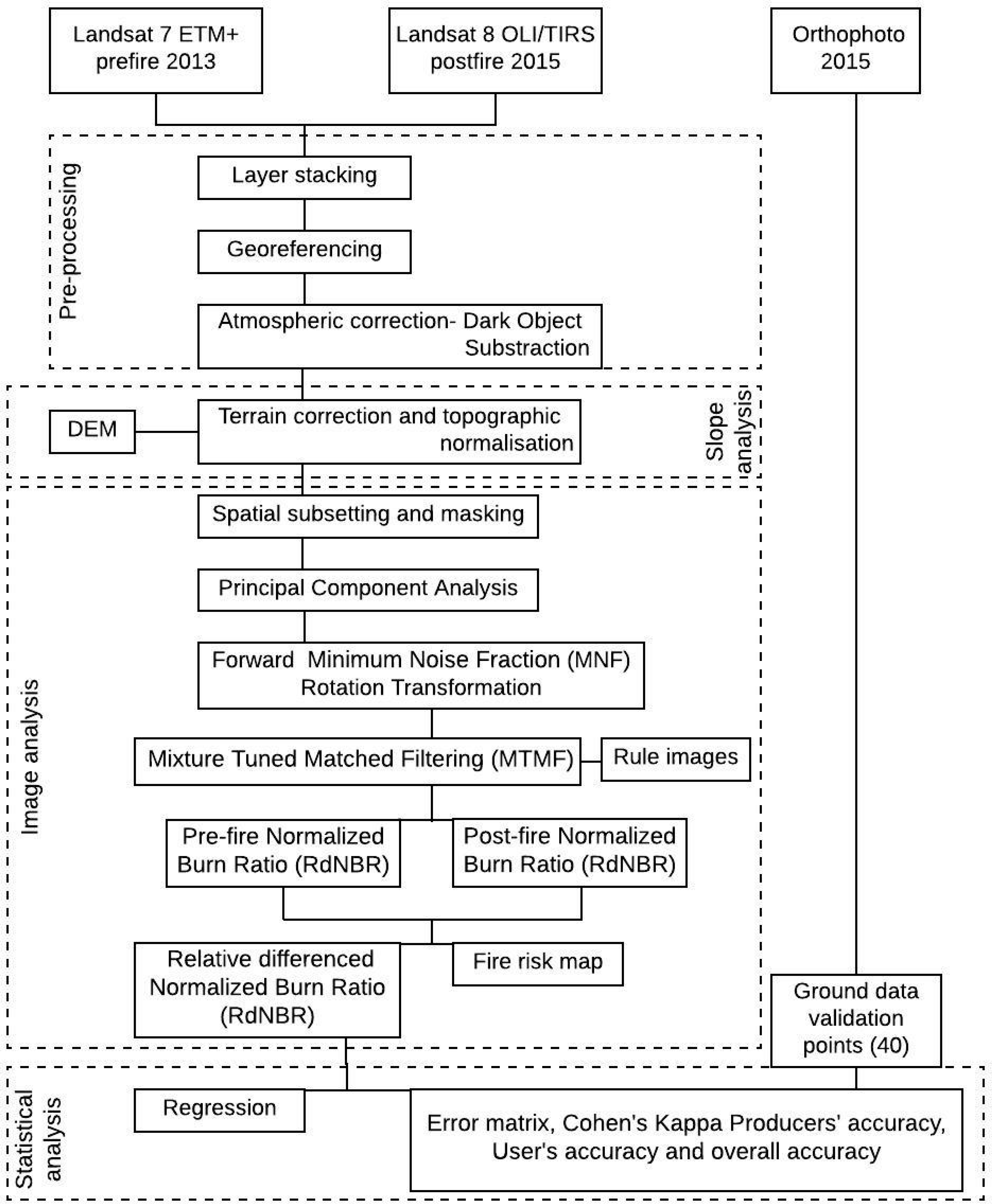


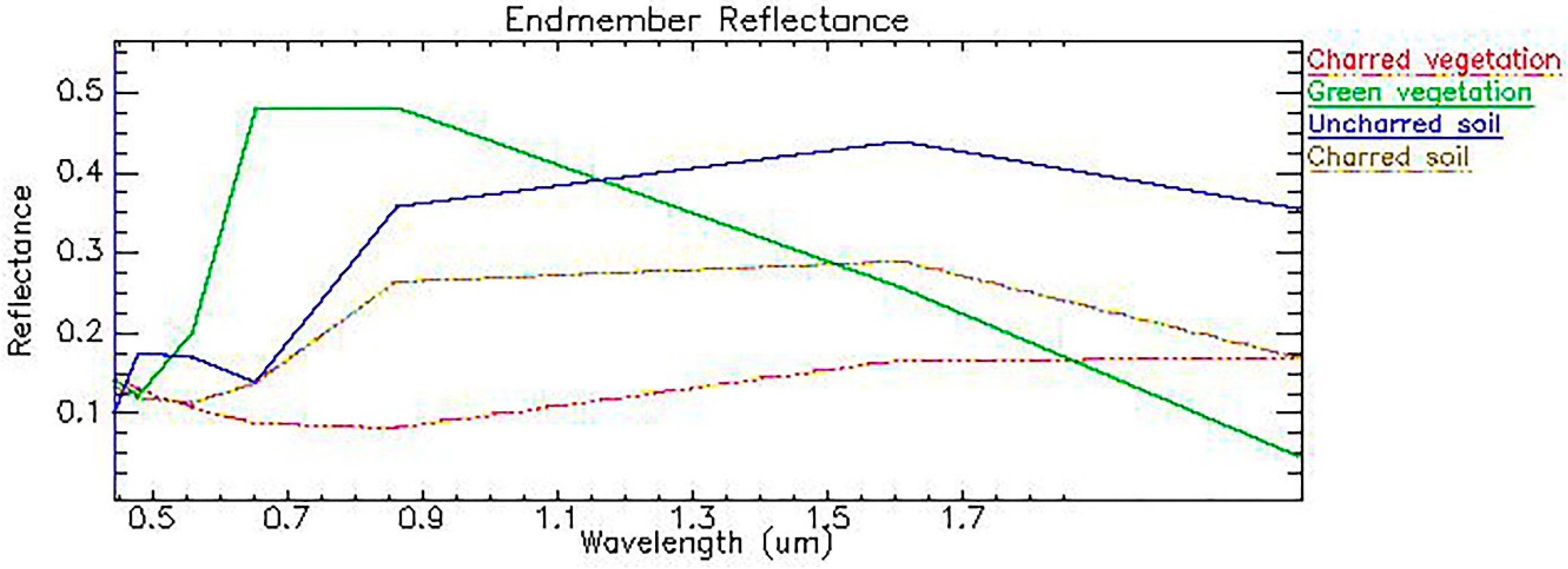
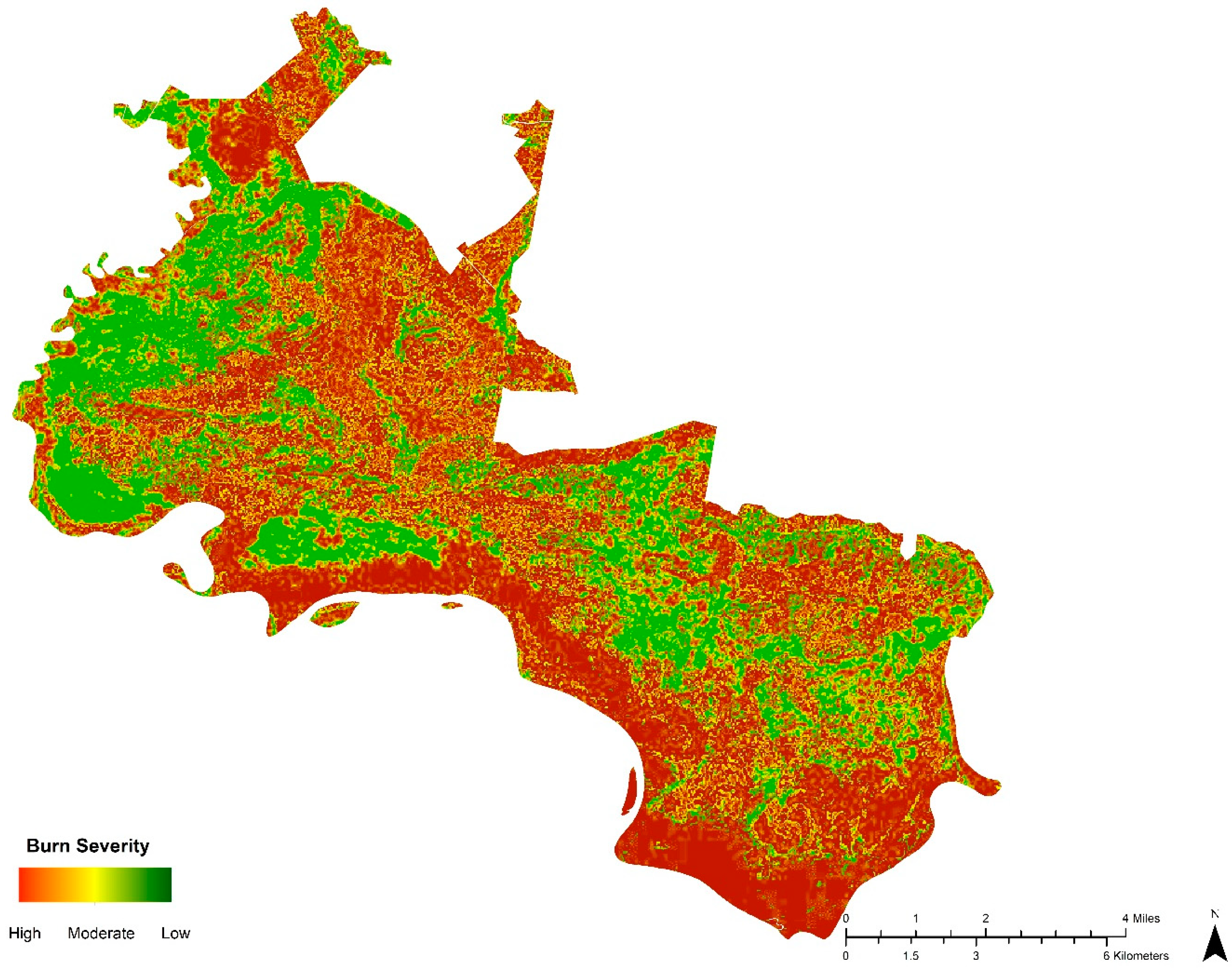
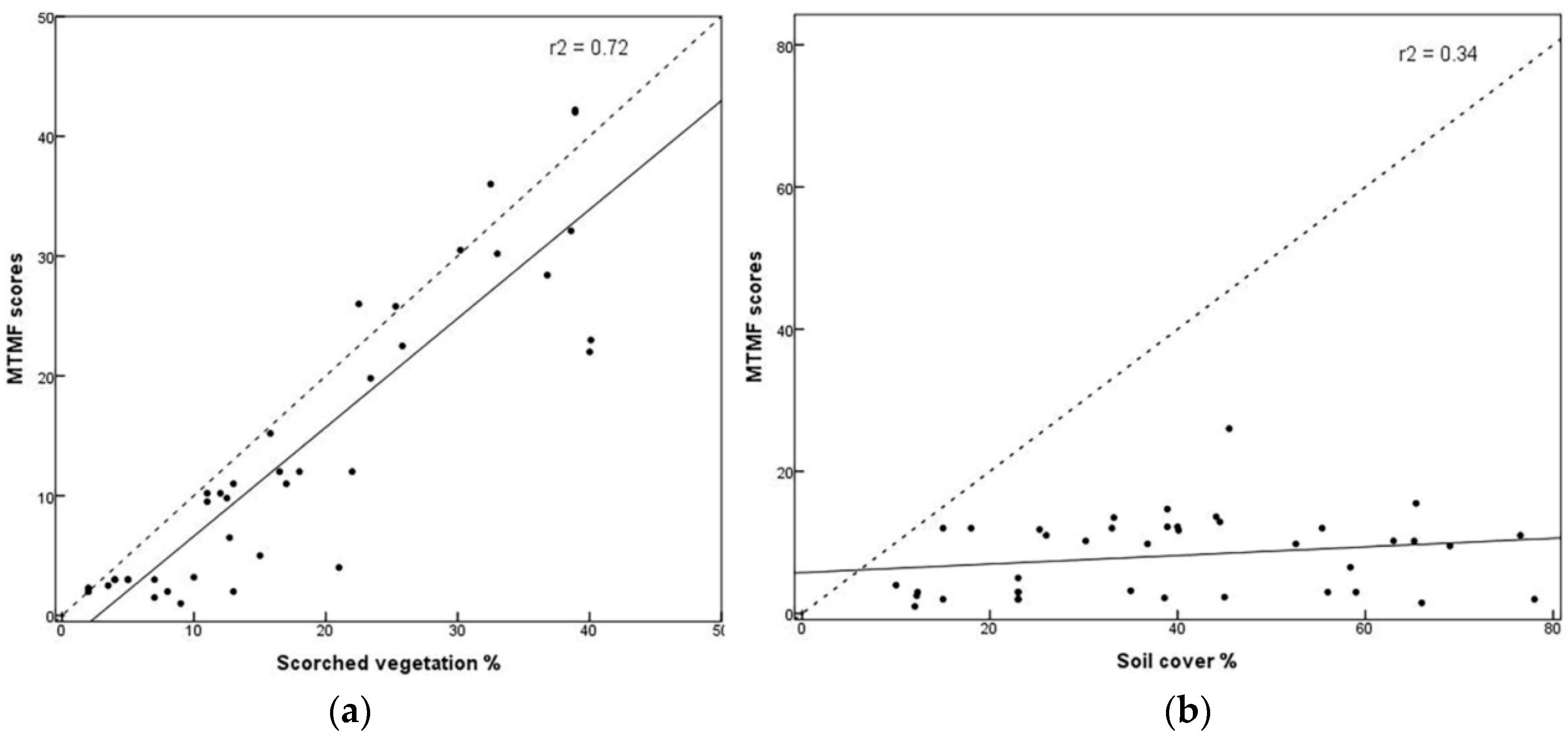
| dNBR | Burn Severity |
|---|---|
| −0.1 to 0.1 | Unburned or no change |
| 0.1 to 0.27 | Low-severity burn |
| 0.27 to 0.44 | Moderate-low severity burn |
| 0.44 to 0.66 | Moderate-high severity burn |
| >0.66 | High-severity burn |
| Ground Cover | MTMF Scores | NBR Values | dNBR Values | RdNBR Values |
|---|---|---|---|---|
| Scorched vegetation (%) | 0.72 | 0.70 | 0.75 | 0.76 |
| Soil cover (%) | 0.34 | 0.55 | 0.51 | 0.53 |
| Category | Unburnt | Low | Moderate | High | Sum | User’s in % |
|---|---|---|---|---|---|---|
| Unburnt/No change | 5 | 5 | 0 | 0 | 10 | 50.00 |
| Low | 6 | 24 | 0 | 0 | 30 | 80.00 |
| Moderate | 0 | 6 | 55 | 4 | 65 | 84.62 |
| High | 0 | 0 | 1 | 78 | 79 | 98.73 |
| Sum | 11 | 35 | 56 | 82 | 184 | |
| Producers in % | 45.45 | 68.57 | 98.21 | 95.12 |
| Category | Unburnt | Low | Moderate | High | Sum | User’s in % |
|---|---|---|---|---|---|---|
| Unburnt/No change | 4 | 5 | 0 | 0 | 9 | 44.44 |
| Low | 6 | 22 | 0 | 0 | 28 | 78.57 |
| Moderate | 0 | 6 | 63 | 4 | 73 | 86.30 |
| High | 0 | 0 | 1 | 79 | 80 | 98.75 |
| Sum | 10 | 33 | 64 | 83 | 190 | |
| Producers in % | 40 | 66.67 | 98.44 | 95.18 |
© 2018 by the authors. Licensee MDPI, Basel, Switzerland. This article is an open access article distributed under the terms and conditions of the Creative Commons Attribution (CC BY) license (http://creativecommons.org/licenses/by/4.0/).
Share and Cite
Rozario, P.F.; Madurapperuma, B.D.; Wang, Y. Remote Sensing Approach to Detect Burn Severity Risk Zones in Palo Verde National Park, Costa Rica. Remote Sens. 2018, 10, 1427. https://doi.org/10.3390/rs10091427
Rozario PF, Madurapperuma BD, Wang Y. Remote Sensing Approach to Detect Burn Severity Risk Zones in Palo Verde National Park, Costa Rica. Remote Sensing. 2018; 10(9):1427. https://doi.org/10.3390/rs10091427
Chicago/Turabian StyleRozario, Papia F., Buddhika D. Madurapperuma, and Yijun Wang. 2018. "Remote Sensing Approach to Detect Burn Severity Risk Zones in Palo Verde National Park, Costa Rica" Remote Sensing 10, no. 9: 1427. https://doi.org/10.3390/rs10091427



